UMUC Report: Effects of Technology in the Agricultural Sector
VerifiedAdded on 2022/11/30
|8
|1910
|79
Report
AI Summary
This report provides an in-depth analysis of the impact of technological advancements on the agricultural sector. It explores the advantages of modern technologies like 3G smartphones and blockchain, which enhance productivity and transparency. The report also discusses the disadvantages, such as the decline in pesticide use and the challenges faced by farmers due to factors like weather conditions and market fluctuations. It highlights the need for training, governmental initiatives, and insurance to support farmers and ensure the sustainable growth of the sector. The report concludes by emphasizing the importance of technology adoption and strategic planning to address the evolving complexities of the agricultural industry and improve the quality of crops.
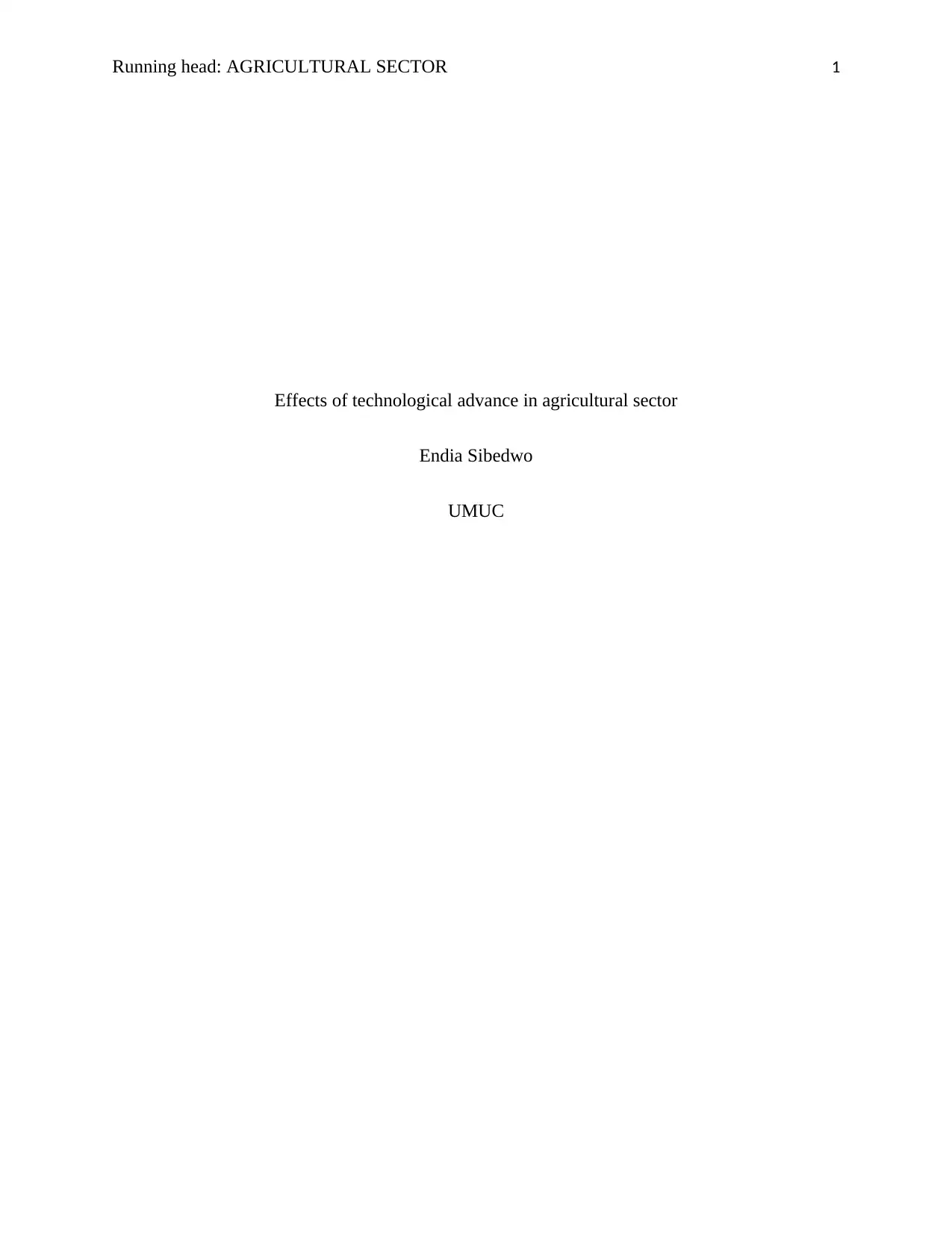
Running head: AGRICULTURAL SECTOR 1
Effects of technological advance in agricultural sector
Endia Sibedwo
UMUC
Effects of technological advance in agricultural sector
Endia Sibedwo
UMUC
Paraphrase This Document
Need a fresh take? Get an instant paraphrase of this document with our AI Paraphraser
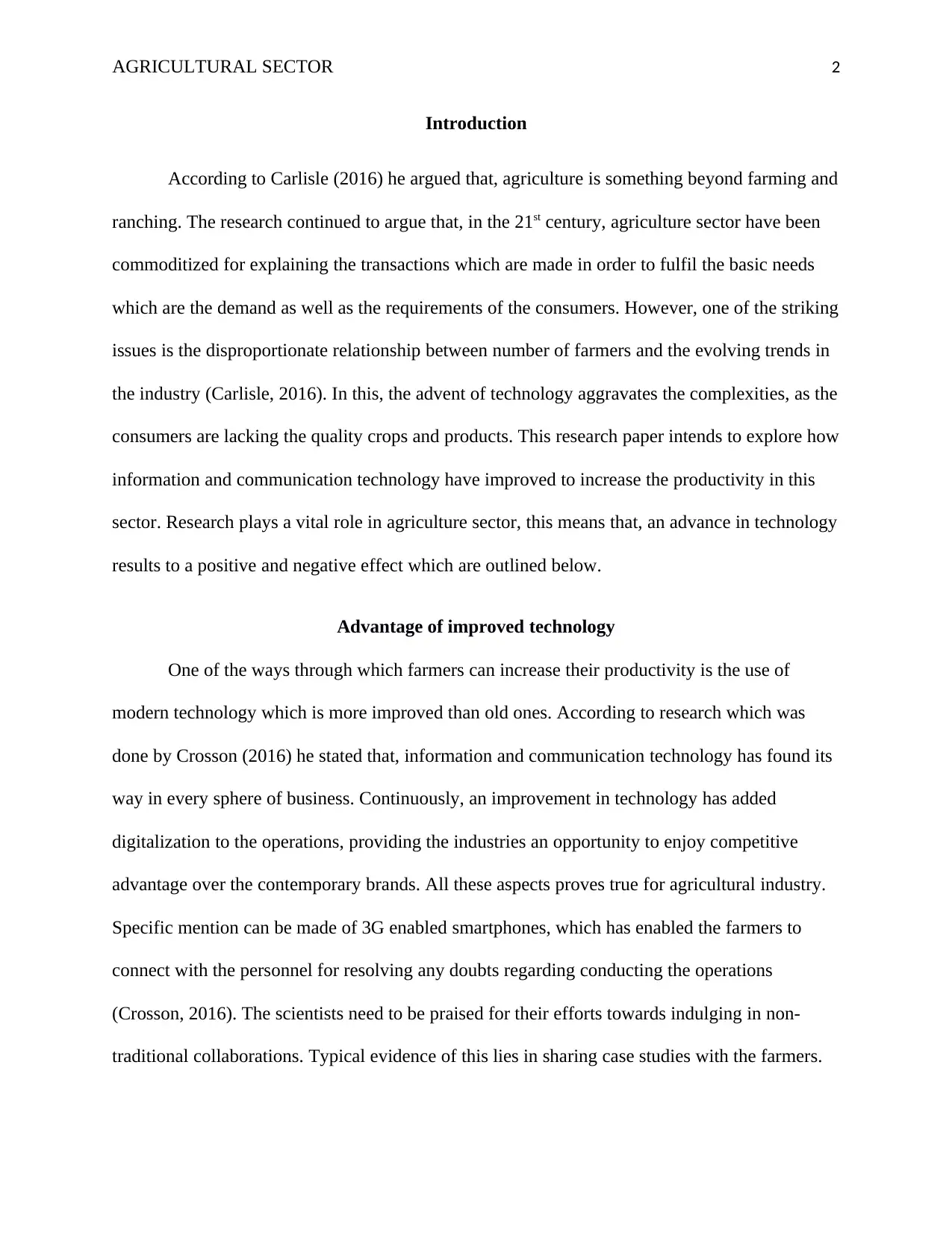
AGRICULTURAL SECTOR 2
Introduction
According to Carlisle (2016) he argued that, agriculture is something beyond farming and
ranching. The research continued to argue that, in the 21st century, agriculture sector have been
commoditized for explaining the transactions which are made in order to fulfil the basic needs
which are the demand as well as the requirements of the consumers. However, one of the striking
issues is the disproportionate relationship between number of farmers and the evolving trends in
the industry (Carlisle, 2016). In this, the advent of technology aggravates the complexities, as the
consumers are lacking the quality crops and products. This research paper intends to explore how
information and communication technology have improved to increase the productivity in this
sector. Research plays a vital role in agriculture sector, this means that, an advance in technology
results to a positive and negative effect which are outlined below.
Advantage of improved technology
One of the ways through which farmers can increase their productivity is the use of
modern technology which is more improved than old ones. According to research which was
done by Crosson (2016) he stated that, information and communication technology has found its
way in every sphere of business. Continuously, an improvement in technology has added
digitalization to the operations, providing the industries an opportunity to enjoy competitive
advantage over the contemporary brands. All these aspects proves true for agricultural industry.
Specific mention can be made of 3G enabled smartphones, which has enabled the farmers to
connect with the personnel for resolving any doubts regarding conducting the operations
(Crosson, 2016). The scientists need to be praised for their efforts towards indulging in non-
traditional collaborations. Typical evidence of this lies in sharing case studies with the farmers.
Introduction
According to Carlisle (2016) he argued that, agriculture is something beyond farming and
ranching. The research continued to argue that, in the 21st century, agriculture sector have been
commoditized for explaining the transactions which are made in order to fulfil the basic needs
which are the demand as well as the requirements of the consumers. However, one of the striking
issues is the disproportionate relationship between number of farmers and the evolving trends in
the industry (Carlisle, 2016). In this, the advent of technology aggravates the complexities, as the
consumers are lacking the quality crops and products. This research paper intends to explore how
information and communication technology have improved to increase the productivity in this
sector. Research plays a vital role in agriculture sector, this means that, an advance in technology
results to a positive and negative effect which are outlined below.
Advantage of improved technology
One of the ways through which farmers can increase their productivity is the use of
modern technology which is more improved than old ones. According to research which was
done by Crosson (2016) he stated that, information and communication technology has found its
way in every sphere of business. Continuously, an improvement in technology has added
digitalization to the operations, providing the industries an opportunity to enjoy competitive
advantage over the contemporary brands. All these aspects proves true for agricultural industry.
Specific mention can be made of 3G enabled smartphones, which has enabled the farmers to
connect with the personnel for resolving any doubts regarding conducting the operations
(Crosson, 2016). The scientists need to be praised for their efforts towards indulging in non-
traditional collaborations. Typical evidence of this lies in sharing case studies with the farmers.
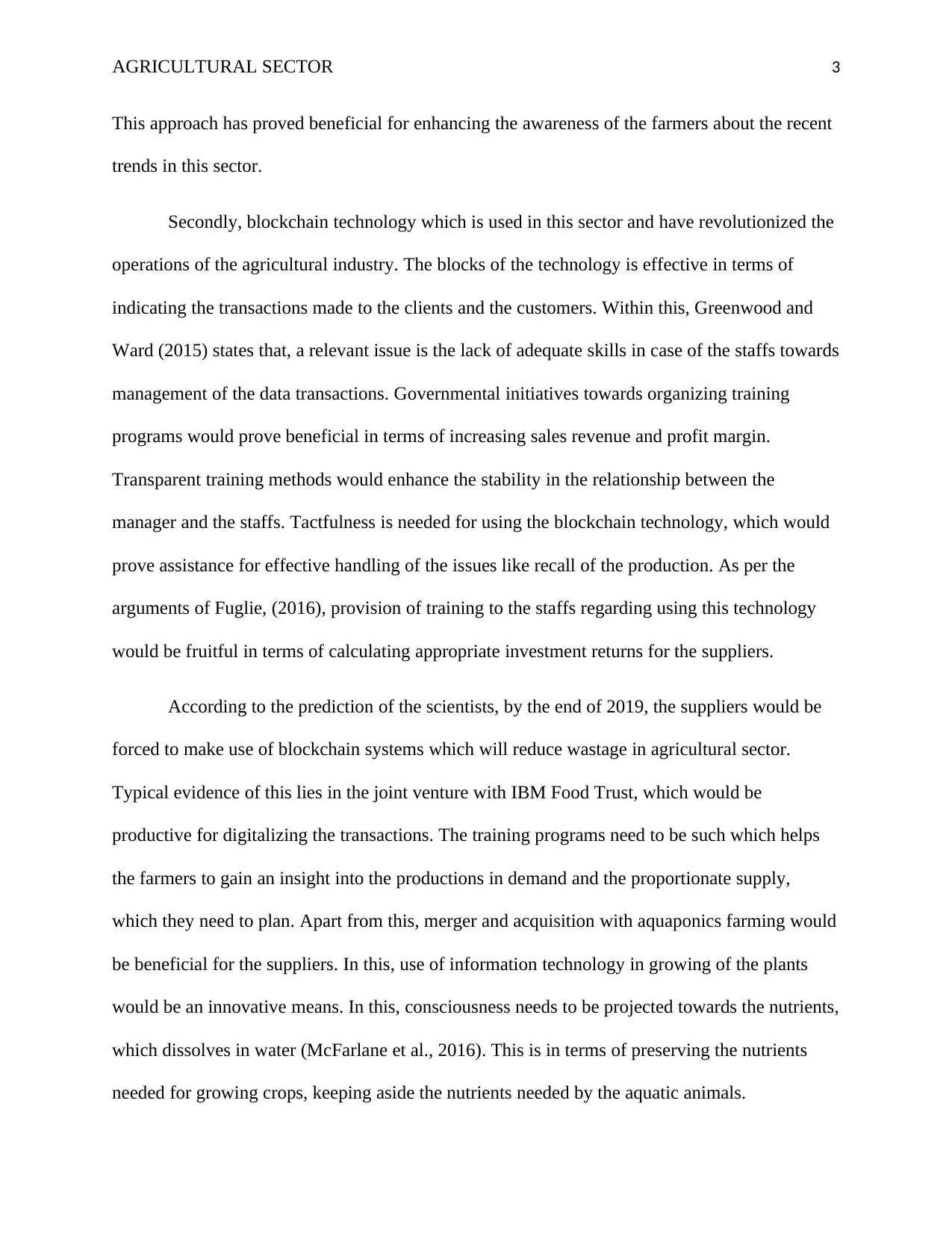
AGRICULTURAL SECTOR 3
This approach has proved beneficial for enhancing the awareness of the farmers about the recent
trends in this sector.
Secondly, blockchain technology which is used in this sector and have revolutionized the
operations of the agricultural industry. The blocks of the technology is effective in terms of
indicating the transactions made to the clients and the customers. Within this, Greenwood and
Ward (2015) states that, a relevant issue is the lack of adequate skills in case of the staffs towards
management of the data transactions. Governmental initiatives towards organizing training
programs would prove beneficial in terms of increasing sales revenue and profit margin.
Transparent training methods would enhance the stability in the relationship between the
manager and the staffs. Tactfulness is needed for using the blockchain technology, which would
prove assistance for effective handling of the issues like recall of the production. As per the
arguments of Fuglie, (2016), provision of training to the staffs regarding using this technology
would be fruitful in terms of calculating appropriate investment returns for the suppliers.
According to the prediction of the scientists, by the end of 2019, the suppliers would be
forced to make use of blockchain systems which will reduce wastage in agricultural sector.
Typical evidence of this lies in the joint venture with IBM Food Trust, which would be
productive for digitalizing the transactions. The training programs need to be such which helps
the farmers to gain an insight into the productions in demand and the proportionate supply,
which they need to plan. Apart from this, merger and acquisition with aquaponics farming would
be beneficial for the suppliers. In this, use of information technology in growing of the plants
would be an innovative means. In this, consciousness needs to be projected towards the nutrients,
which dissolves in water (McFarlane et al., 2016). This is in terms of preserving the nutrients
needed for growing crops, keeping aside the nutrients needed by the aquatic animals.
This approach has proved beneficial for enhancing the awareness of the farmers about the recent
trends in this sector.
Secondly, blockchain technology which is used in this sector and have revolutionized the
operations of the agricultural industry. The blocks of the technology is effective in terms of
indicating the transactions made to the clients and the customers. Within this, Greenwood and
Ward (2015) states that, a relevant issue is the lack of adequate skills in case of the staffs towards
management of the data transactions. Governmental initiatives towards organizing training
programs would prove beneficial in terms of increasing sales revenue and profit margin.
Transparent training methods would enhance the stability in the relationship between the
manager and the staffs. Tactfulness is needed for using the blockchain technology, which would
prove assistance for effective handling of the issues like recall of the production. As per the
arguments of Fuglie, (2016), provision of training to the staffs regarding using this technology
would be fruitful in terms of calculating appropriate investment returns for the suppliers.
According to the prediction of the scientists, by the end of 2019, the suppliers would be
forced to make use of blockchain systems which will reduce wastage in agricultural sector.
Typical evidence of this lies in the joint venture with IBM Food Trust, which would be
productive for digitalizing the transactions. The training programs need to be such which helps
the farmers to gain an insight into the productions in demand and the proportionate supply,
which they need to plan. Apart from this, merger and acquisition with aquaponics farming would
be beneficial for the suppliers. In this, use of information technology in growing of the plants
would be an innovative means. In this, consciousness needs to be projected towards the nutrients,
which dissolves in water (McFarlane et al., 2016). This is in terms of preserving the nutrients
needed for growing crops, keeping aside the nutrients needed by the aquatic animals.
⊘ This is a preview!⊘
Do you want full access?
Subscribe today to unlock all pages.

Trusted by 1+ million students worldwide
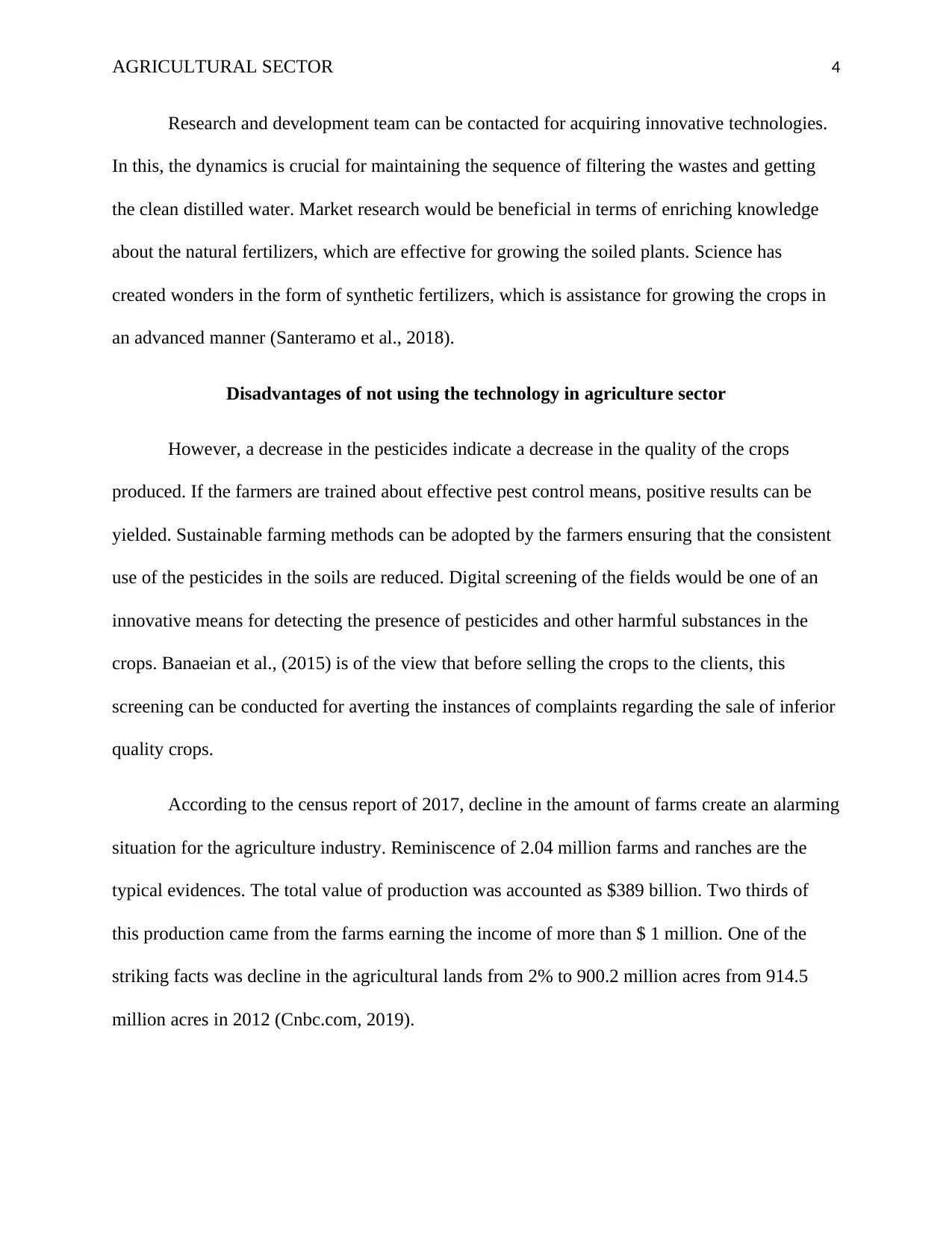
AGRICULTURAL SECTOR 4
Research and development team can be contacted for acquiring innovative technologies.
In this, the dynamics is crucial for maintaining the sequence of filtering the wastes and getting
the clean distilled water. Market research would be beneficial in terms of enriching knowledge
about the natural fertilizers, which are effective for growing the soiled plants. Science has
created wonders in the form of synthetic fertilizers, which is assistance for growing the crops in
an advanced manner (Santeramo et al., 2018).
Disadvantages of not using the technology in agriculture sector
However, a decrease in the pesticides indicate a decrease in the quality of the crops
produced. If the farmers are trained about effective pest control means, positive results can be
yielded. Sustainable farming methods can be adopted by the farmers ensuring that the consistent
use of the pesticides in the soils are reduced. Digital screening of the fields would be one of an
innovative means for detecting the presence of pesticides and other harmful substances in the
crops. Banaeian et al., (2015) is of the view that before selling the crops to the clients, this
screening can be conducted for averting the instances of complaints regarding the sale of inferior
quality crops.
According to the census report of 2017, decline in the amount of farms create an alarming
situation for the agriculture industry. Reminiscence of 2.04 million farms and ranches are the
typical evidences. The total value of production was accounted as $389 billion. Two thirds of
this production came from the farms earning the income of more than $ 1 million. One of the
striking facts was decline in the agricultural lands from 2% to 900.2 million acres from 914.5
million acres in 2012 (Cnbc.com, 2019).
Research and development team can be contacted for acquiring innovative technologies.
In this, the dynamics is crucial for maintaining the sequence of filtering the wastes and getting
the clean distilled water. Market research would be beneficial in terms of enriching knowledge
about the natural fertilizers, which are effective for growing the soiled plants. Science has
created wonders in the form of synthetic fertilizers, which is assistance for growing the crops in
an advanced manner (Santeramo et al., 2018).
Disadvantages of not using the technology in agriculture sector
However, a decrease in the pesticides indicate a decrease in the quality of the crops
produced. If the farmers are trained about effective pest control means, positive results can be
yielded. Sustainable farming methods can be adopted by the farmers ensuring that the consistent
use of the pesticides in the soils are reduced. Digital screening of the fields would be one of an
innovative means for detecting the presence of pesticides and other harmful substances in the
crops. Banaeian et al., (2015) is of the view that before selling the crops to the clients, this
screening can be conducted for averting the instances of complaints regarding the sale of inferior
quality crops.
According to the census report of 2017, decline in the amount of farms create an alarming
situation for the agriculture industry. Reminiscence of 2.04 million farms and ranches are the
typical evidences. The total value of production was accounted as $389 billion. Two thirds of
this production came from the farms earning the income of more than $ 1 million. One of the
striking facts was decline in the agricultural lands from 2% to 900.2 million acres from 914.5
million acres in 2012 (Cnbc.com, 2019).
Paraphrase This Document
Need a fresh take? Get an instant paraphrase of this document with our AI Paraphraser
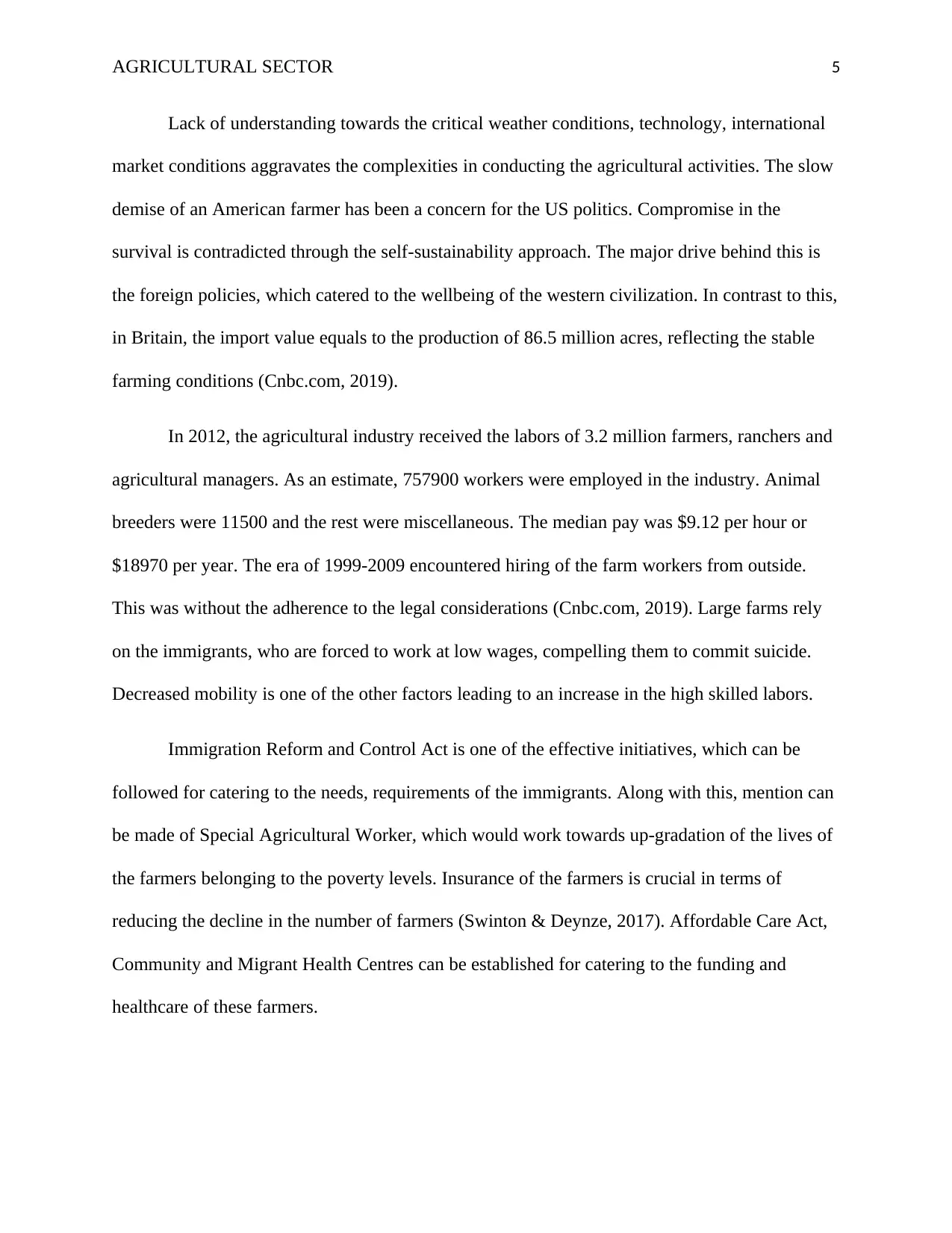
AGRICULTURAL SECTOR 5
Lack of understanding towards the critical weather conditions, technology, international
market conditions aggravates the complexities in conducting the agricultural activities. The slow
demise of an American farmer has been a concern for the US politics. Compromise in the
survival is contradicted through the self-sustainability approach. The major drive behind this is
the foreign policies, which catered to the wellbeing of the western civilization. In contrast to this,
in Britain, the import value equals to the production of 86.5 million acres, reflecting the stable
farming conditions (Cnbc.com, 2019).
In 2012, the agricultural industry received the labors of 3.2 million farmers, ranchers and
agricultural managers. As an estimate, 757900 workers were employed in the industry. Animal
breeders were 11500 and the rest were miscellaneous. The median pay was $9.12 per hour or
$18970 per year. The era of 1999-2009 encountered hiring of the farm workers from outside.
This was without the adherence to the legal considerations (Cnbc.com, 2019). Large farms rely
on the immigrants, who are forced to work at low wages, compelling them to commit suicide.
Decreased mobility is one of the other factors leading to an increase in the high skilled labors.
Immigration Reform and Control Act is one of the effective initiatives, which can be
followed for catering to the needs, requirements of the immigrants. Along with this, mention can
be made of Special Agricultural Worker, which would work towards up-gradation of the lives of
the farmers belonging to the poverty levels. Insurance of the farmers is crucial in terms of
reducing the decline in the number of farmers (Swinton & Deynze, 2017). Affordable Care Act,
Community and Migrant Health Centres can be established for catering to the funding and
healthcare of these farmers.
Lack of understanding towards the critical weather conditions, technology, international
market conditions aggravates the complexities in conducting the agricultural activities. The slow
demise of an American farmer has been a concern for the US politics. Compromise in the
survival is contradicted through the self-sustainability approach. The major drive behind this is
the foreign policies, which catered to the wellbeing of the western civilization. In contrast to this,
in Britain, the import value equals to the production of 86.5 million acres, reflecting the stable
farming conditions (Cnbc.com, 2019).
In 2012, the agricultural industry received the labors of 3.2 million farmers, ranchers and
agricultural managers. As an estimate, 757900 workers were employed in the industry. Animal
breeders were 11500 and the rest were miscellaneous. The median pay was $9.12 per hour or
$18970 per year. The era of 1999-2009 encountered hiring of the farm workers from outside.
This was without the adherence to the legal considerations (Cnbc.com, 2019). Large farms rely
on the immigrants, who are forced to work at low wages, compelling them to commit suicide.
Decreased mobility is one of the other factors leading to an increase in the high skilled labors.
Immigration Reform and Control Act is one of the effective initiatives, which can be
followed for catering to the needs, requirements of the immigrants. Along with this, mention can
be made of Special Agricultural Worker, which would work towards up-gradation of the lives of
the farmers belonging to the poverty levels. Insurance of the farmers is crucial in terms of
reducing the decline in the number of farmers (Swinton & Deynze, 2017). Affordable Care Act,
Community and Migrant Health Centres can be established for catering to the funding and
healthcare of these farmers.
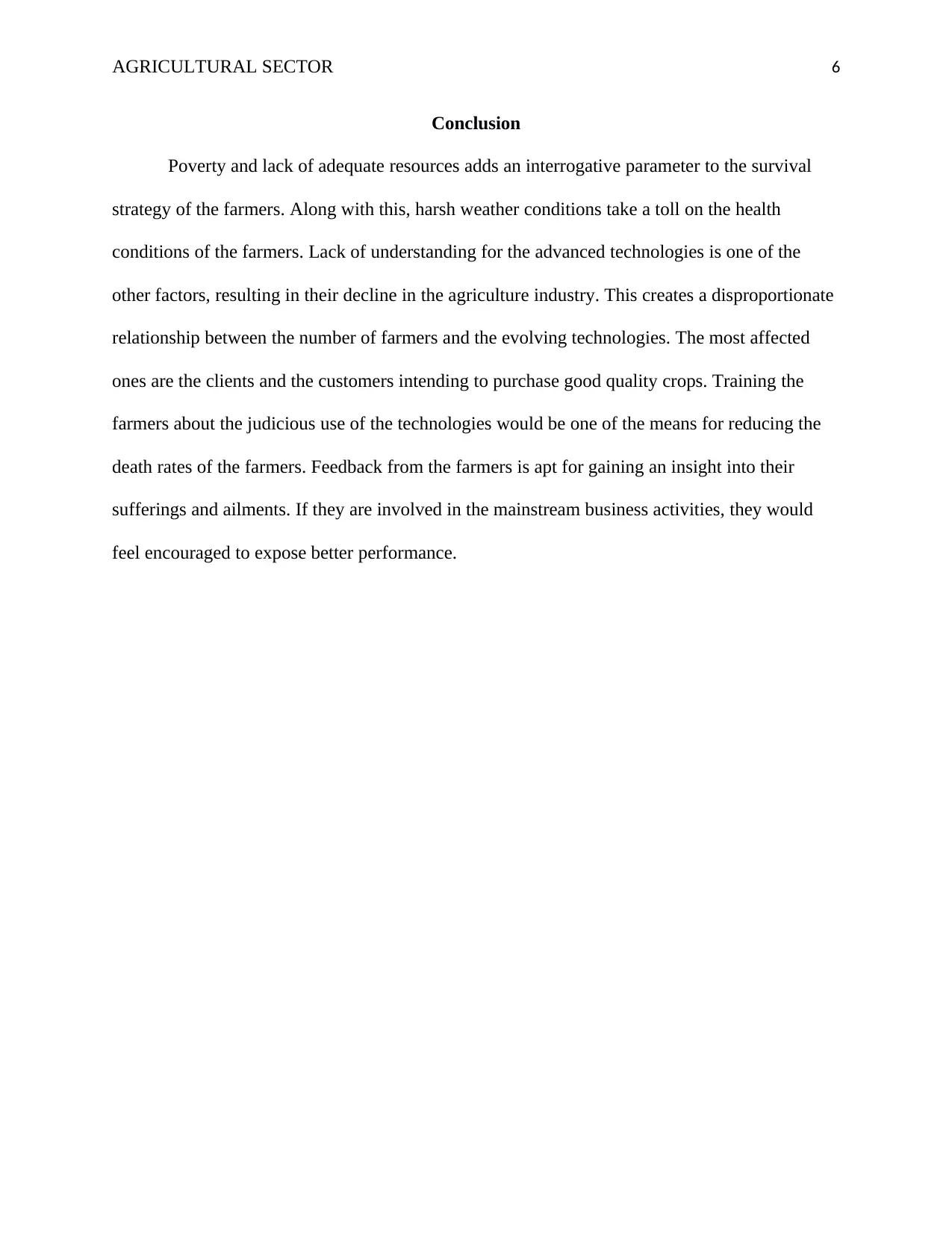
AGRICULTURAL SECTOR 6
Conclusion
Poverty and lack of adequate resources adds an interrogative parameter to the survival
strategy of the farmers. Along with this, harsh weather conditions take a toll on the health
conditions of the farmers. Lack of understanding for the advanced technologies is one of the
other factors, resulting in their decline in the agriculture industry. This creates a disproportionate
relationship between the number of farmers and the evolving technologies. The most affected
ones are the clients and the customers intending to purchase good quality crops. Training the
farmers about the judicious use of the technologies would be one of the means for reducing the
death rates of the farmers. Feedback from the farmers is apt for gaining an insight into their
sufferings and ailments. If they are involved in the mainstream business activities, they would
feel encouraged to expose better performance.
Conclusion
Poverty and lack of adequate resources adds an interrogative parameter to the survival
strategy of the farmers. Along with this, harsh weather conditions take a toll on the health
conditions of the farmers. Lack of understanding for the advanced technologies is one of the
other factors, resulting in their decline in the agriculture industry. This creates a disproportionate
relationship between the number of farmers and the evolving technologies. The most affected
ones are the clients and the customers intending to purchase good quality crops. Training the
farmers about the judicious use of the technologies would be one of the means for reducing the
death rates of the farmers. Feedback from the farmers is apt for gaining an insight into their
sufferings and ailments. If they are involved in the mainstream business activities, they would
feel encouraged to expose better performance.
⊘ This is a preview!⊘
Do you want full access?
Subscribe today to unlock all pages.

Trusted by 1+ million students worldwide
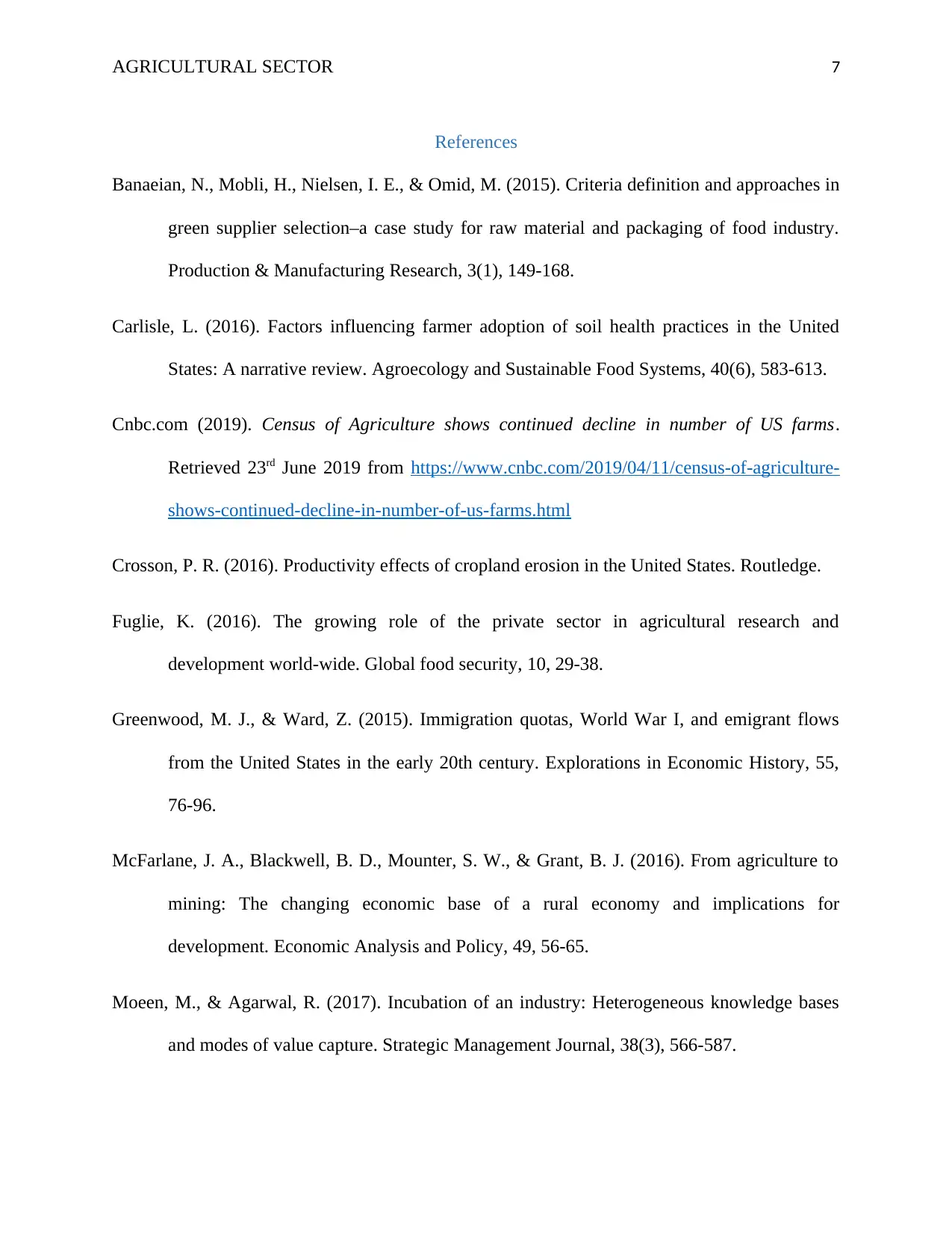
AGRICULTURAL SECTOR 7
References
Banaeian, N., Mobli, H., Nielsen, I. E., & Omid, M. (2015). Criteria definition and approaches in
green supplier selection–a case study for raw material and packaging of food industry.
Production & Manufacturing Research, 3(1), 149-168.
Carlisle, L. (2016). Factors influencing farmer adoption of soil health practices in the United
States: A narrative review. Agroecology and Sustainable Food Systems, 40(6), 583-613.
Cnbc.com (2019). Census of Agriculture shows continued decline in number of US farms.
Retrieved 23rd June 2019 from https://www.cnbc.com/2019/04/11/census-of-agriculture-
shows-continued-decline-in-number-of-us-farms.html
Crosson, P. R. (2016). Productivity effects of cropland erosion in the United States. Routledge.
Fuglie, K. (2016). The growing role of the private sector in agricultural research and
development world-wide. Global food security, 10, 29-38.
Greenwood, M. J., & Ward, Z. (2015). Immigration quotas, World War I, and emigrant flows
from the United States in the early 20th century. Explorations in Economic History, 55,
76-96.
McFarlane, J. A., Blackwell, B. D., Mounter, S. W., & Grant, B. J. (2016). From agriculture to
mining: The changing economic base of a rural economy and implications for
development. Economic Analysis and Policy, 49, 56-65.
Moeen, M., & Agarwal, R. (2017). Incubation of an industry: Heterogeneous knowledge bases
and modes of value capture. Strategic Management Journal, 38(3), 566-587.
References
Banaeian, N., Mobli, H., Nielsen, I. E., & Omid, M. (2015). Criteria definition and approaches in
green supplier selection–a case study for raw material and packaging of food industry.
Production & Manufacturing Research, 3(1), 149-168.
Carlisle, L. (2016). Factors influencing farmer adoption of soil health practices in the United
States: A narrative review. Agroecology and Sustainable Food Systems, 40(6), 583-613.
Cnbc.com (2019). Census of Agriculture shows continued decline in number of US farms.
Retrieved 23rd June 2019 from https://www.cnbc.com/2019/04/11/census-of-agriculture-
shows-continued-decline-in-number-of-us-farms.html
Crosson, P. R. (2016). Productivity effects of cropland erosion in the United States. Routledge.
Fuglie, K. (2016). The growing role of the private sector in agricultural research and
development world-wide. Global food security, 10, 29-38.
Greenwood, M. J., & Ward, Z. (2015). Immigration quotas, World War I, and emigrant flows
from the United States in the early 20th century. Explorations in Economic History, 55,
76-96.
McFarlane, J. A., Blackwell, B. D., Mounter, S. W., & Grant, B. J. (2016). From agriculture to
mining: The changing economic base of a rural economy and implications for
development. Economic Analysis and Policy, 49, 56-65.
Moeen, M., & Agarwal, R. (2017). Incubation of an industry: Heterogeneous knowledge bases
and modes of value capture. Strategic Management Journal, 38(3), 566-587.
Paraphrase This Document
Need a fresh take? Get an instant paraphrase of this document with our AI Paraphraser
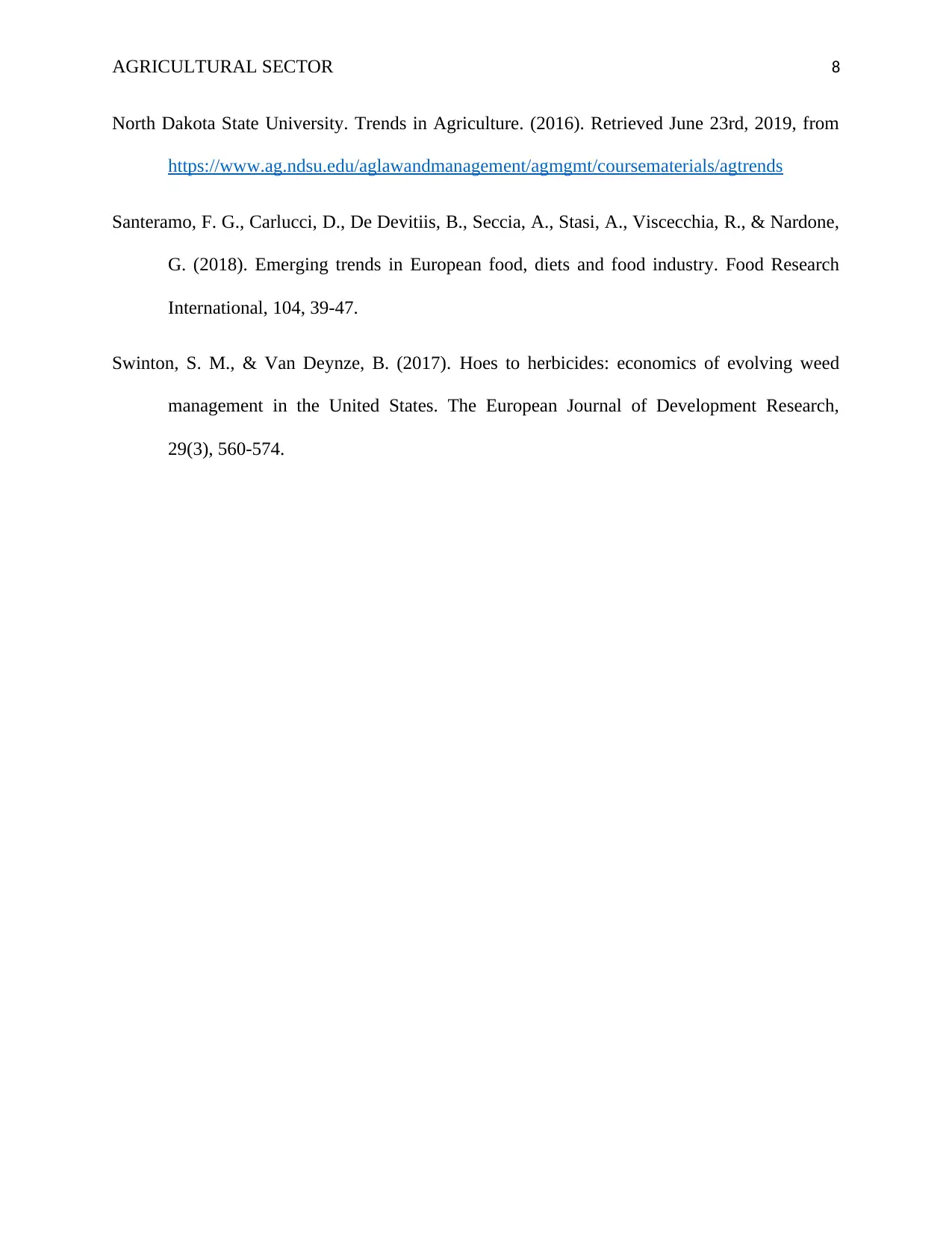
AGRICULTURAL SECTOR 8
North Dakota State University. Trends in Agriculture. (2016). Retrieved June 23rd, 2019, from
https://www.ag.ndsu.edu/aglawandmanagement/agmgmt/coursematerials/agtrends
Santeramo, F. G., Carlucci, D., De Devitiis, B., Seccia, A., Stasi, A., Viscecchia, R., & Nardone,
G. (2018). Emerging trends in European food, diets and food industry. Food Research
International, 104, 39-47.
Swinton, S. M., & Van Deynze, B. (2017). Hoes to herbicides: economics of evolving weed
management in the United States. The European Journal of Development Research,
29(3), 560-574.
North Dakota State University. Trends in Agriculture. (2016). Retrieved June 23rd, 2019, from
https://www.ag.ndsu.edu/aglawandmanagement/agmgmt/coursematerials/agtrends
Santeramo, F. G., Carlucci, D., De Devitiis, B., Seccia, A., Stasi, A., Viscecchia, R., & Nardone,
G. (2018). Emerging trends in European food, diets and food industry. Food Research
International, 104, 39-47.
Swinton, S. M., & Van Deynze, B. (2017). Hoes to herbicides: economics of evolving weed
management in the United States. The European Journal of Development Research,
29(3), 560-574.
1 out of 8
Related Documents
Your All-in-One AI-Powered Toolkit for Academic Success.
+13062052269
info@desklib.com
Available 24*7 on WhatsApp / Email
![[object Object]](/_next/static/media/star-bottom.7253800d.svg)
Unlock your academic potential
Copyright © 2020–2025 A2Z Services. All Rights Reserved. Developed and managed by ZUCOL.




